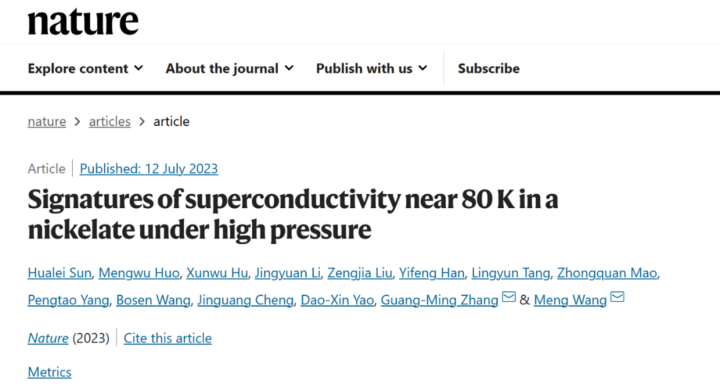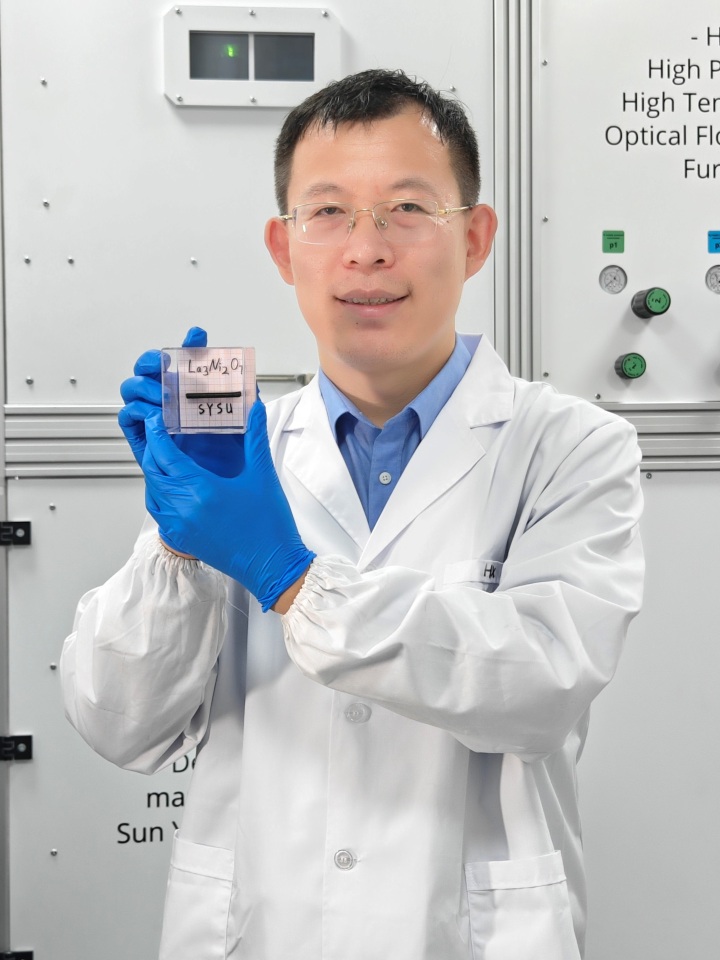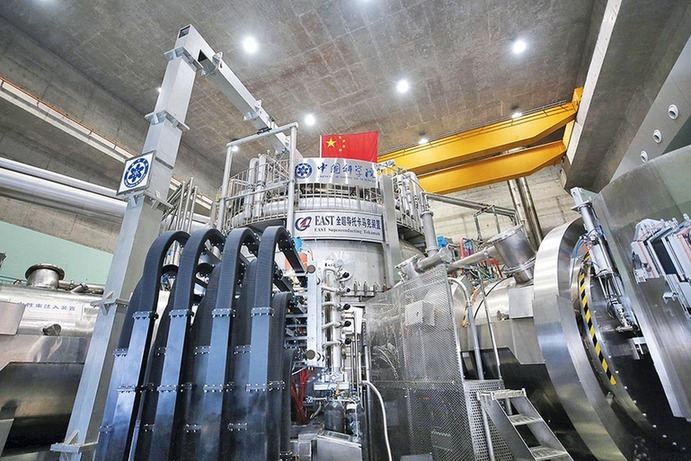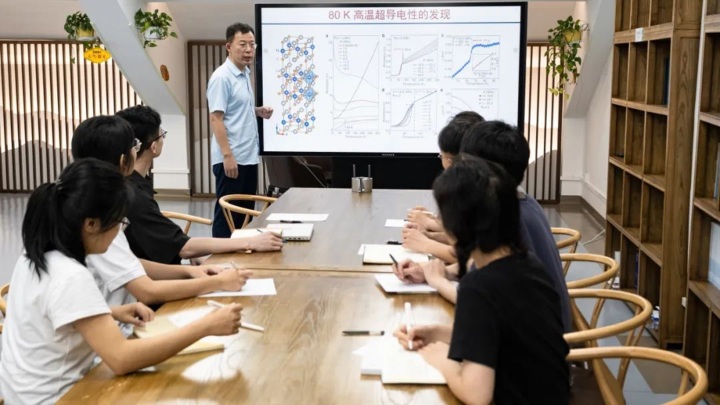What is China's ranking?, Global Superconducting Team | Liquid Nitrogen | Global Competition
Recently, a team of South Korean scientists announced the synthesis of the world's first room temperature and atmospheric pressure superconductor, sparking heated discussions and differing opinions.
Superconductors, also known as superconducting materials, refer to conductors with zero resistance at a certain temperature and can be widely used in energy storage, maglev trains, power transmission, nuclear magnetic resonance, and other fields. Since the discovery of superconductivity by humans, five related Nobel Prizes have been awarded in this field. Chinese scientists have also won the National Natural Science First Prize twice and the National Supreme Science and Technology Award once for their breakthroughs in the field of superconductivity.
However, the implementation of superconducting materials is not easy, such as requiring ultra-high pressure - as some science writers have put it, there is a type of superconducting material that requires ultra-high pressure, similar to an elephant carrying three to four hundred elephants, wearing a thin high heel shoe, and then stomping the force of that size with the thin high heel shoe.
Is there any superconducting material in the world under indoor atmospheric pressure conditions? There is currently a type, but it appears in the science fiction movie Avatar: a room temperature superconducting ore called Unobtanium, which can suspend mountains in the air. Luo Huiqian, Institute of Physics, Chinese Academy of Sciences, once said in an article that scientists engaged in superconducting research also have an ultimate dream, that is, to find practical room temperature superconducting materials.
Nowadays, as the development of new superconducting materials that can be applied on a large scale has become a goal of global technological competition, how are Chinese scientists doing?
The journal Nature published a scientific achievement led by Professor Wang Meng's team at Sun Yat sen University: the first discovery of nickel oxide superconductors in the liquid nitrogen temperature range. Image from the official website of Sun Yat sen University
Some fields have achieved breakthroughs from 0 to 1

At present, China has reached a world leading level in some research directions of superconductivity and is constantly making new breakthroughs.
At 11:00 pm Beijing time on July 12th, the international top journal Nature published a scientific achievement led by Professor Wang Meng's team from Sun Yat sen University: the first discovery of nickel oxide superconductors in the liquid nitrogen temperature range.
This is a new high-temperature superconducting system discovered by Chinese scientists globally, and is currently the second unconventional superconducting material discovered by humans in the liquid nitrogen temperature range. It is regarded as a breakthrough in the field of basic research from 0 to 1.
To understand the significance of this discovery, Chao News reporters will first briefly outline the history of superconductivity development.
In 1911, Dutch physicist Hennes first discovered the phenomenon of superconductivity. At that time, he cooled the mercury to 4K, which was close to absolute zero. Since then, scientists have been searching for high-temperature superconducting materials.
In the 1980s, led by a team led by Professor Zhao Zhongxian from the Institute of Physics, Chinese Academy of Sciences, China quickly discovered the phenomenon of high-temperature superconductivity of copper oxides above 90K, breaking the traditional upper limit of the transition temperature of superconductors that generally cannot exceed 40K. Zhao Zhongxian's research team won the first prize of the National Natural Science Award in 1989 for their outstanding achievements.
In 2008, Zhao Zhongxian's team raised the critical temperature of iron-based superconductors to 55 K, promoting China's research on high-temperature superconductivity to the forefront of the world. The American journal Science published a commentary titled "New Superconductors Pushing Chinese Physicists to the Frontiers", affirming the significant and leading work carried out by Chinese physicists.

Since then, many new iron-based superconducting materials, including physical property research on superconducting mechanisms, have been initiated by Chinese scientists. According to Luo Huiqian, a researcher at the Institute of Physics of the Chinese Academy of Sciences, until today, China has been in the forefront of the world in the basic research field of superconductivity, namely materials and mechanisms.
In January 2014, the Institute of Physics of the Chinese Academy of Sciences and the research team of the University of Science and Technology of China, represented by Zhao Zhongxian, Chen Xianhui, Wang Nanlin, Wen Haihu and Fang Zhong, won the first prize of 2013 National Natural Science Award by virtue of the "discovery of iron based high-temperature superconductors above 40K and research on some basic physical properties". Three years later, Academician Zhao Zhongxian won the highest national science and technology award in 2016.
In the development of high-temperature superconducting materials, the liquid nitrogen temperature range is particularly special. Because liquid nitrogen is cheaper and easier to obtain compared to other materials. This has promoted the application of copper oxide high-temperature superconducting materials in fields such as information technology, biomedical, scientific instruments, electricity, and transportation.
However, copper oxide remains the only unconventional superconducting material in the liquid nitrogen temperature range. "Scientists have mastered many experimental phenomena and laws in the study of copper oxide superconductivity, but the causal relationship with high-temperature superconductivity cannot be determined." Professor Zhang Guangming from Tsinghua University said that the mechanism of high-temperature superconductivity is still unknown and has become one of the most important scientific problems in physics in the past 40 years.
Professor Wang Meng showcases single crystals of nickel oxide La æ Ni ₂ O ₇. Image provided by Sun Yat sen University
This time, Wang Meng's team discovered for the first time the superconducting nickel oxide in the liquid nitrogen temperature range. According to Professor Wang Meng, the electronic structure and magnetism of nickel oxide are completely different from those of copper oxide. Through comparative research, it is possible to determine the key factors of high-temperature superconductivity and promote scientists to decipher the mechanism of high-temperature superconductivity.
If you pay close attention to the progress of superconductivity research in China, you will also find many news: for example, in June this year, a team from the University of Science and Technology of China published a paper in the world's top physics journal "Physical Review Express", setting a new record for the transition temperature of elemental superconductors. In 2014, the team led by Ma Yanming from Jilin University predicted that hydrogen sulfide could become a superconductor at 1.6 million atmospheres, with a superconducting critical temperature of 80 K; Another team led by Jida, Cui Tian, predicted that the H2S-H2 compound may achieve high-temperature superconductivity of 191-204 K under high pressure.

Superconducting cables. Image from Shangguan
More superconducting materials applied in daily life
The leading position of superconductivity in China cannot be achieved without strong national support and its application in multiple fields.
In the 1960s and 1970s, China began researching superconductivity. Shortly after the birth of the 863 Plan, superconductivity was included as a special project. During the "15th Five Year Plan" period, the government provided strong support for the "863" superconducting project. At that time, the Ministry of Science and Technology invested about 100 million yuan, and with investment from various sectors of society, the total funding for the project was about 400 million yuan. This special project has achieved fruitful results, with some of them fully reaching the world's advanced level.
In recent years, top-level designs and policies related to superconductivity at the national level have also been intensively introduced. In December 2021, the Ministry of Industry and Information Technology, together with the Ministry of Science and Technology and the Ministry of Natural Resources, released the "14th Five Year Plan" for the development of raw material industry, proposing to implement forward-looking layout actions for cutting-edge materials, support scientific research units to unite with enterprises, grasp the trend of integrating new material technology with information technology, nanotechnology, intelligent technology, etc., develop superconducting materials, intelligent biomimetics, additive manufacturing materials, etc., promote the systematic development of new backbone materials, and strengthen support and guidance in application fields. This is seen by the industry as a clear positioning of superconducting materials in modern industries.
The importance of superconductivity cannot be separated from its enormous application value. For example, in the field of superconducting cables, China has achieved practical applications.
Superconducting materials can make the power transmission medium approach zero resistance, and the power transmission loss approaches zero. A 35 kV superconducting cable is equivalent to the transmission capacity of a traditional 220 kV cable, and can replace 4 to 6 traditional cables of the same voltage level, saving 70% of underground pipeline space compared to the past. In China, it is reported that the annual loss of electricity transmission can reach hundreds of billions of kilowatt hours. If replaced with superconducting materials, the energy saved is equivalent to building dozens of large power plants.

In 2004, China's first superconducting cable system was officially connected to the grid. China has become the third country in the world to put superconducting cables into power grid operation, following the United States and Denmark. In 2013, the first 30 meter, 35 kV low-temperature insulated high-temperature superconducting cable was put into operation in China, marking a breakthrough in practical low-temperature insulated high-temperature superconducting cable technology. In December 2021, the world's first commercial demonstration section of super kilometer level high-temperature superconducting cables was officially put into operation in Shanghai, marking that China's superconducting transmission application has entered the world's leading ranks
Professor Wen Haihu from Nanjing University, Changjiang Scholar Distinguished Professor, and Fellow of the American Physical Society, recently introduced in a media interview that superconducting materials have actually been applied in many industries, such as magnets for nuclear fusion research, magnets for hospital core magnetic imaging, high-frequency filters, quantum computing, and so on.
In September 2016, while the preparation of iron-based superconducting wires in countries such as the United States, Japan, and Europe was still at the meter level, the team led by Ma Yanwei, a researcher at the Institute of Electrical Engineering, Chinese Academy of Sciences, successfully developed the first international iron-based superconducting long wire at the 100 meter level. This is a new milestone in the industrialization of iron-based superconducting materials from laboratory research.
Changsha Maglev. Image from Hunan Release
In China, superconductivity is well-known to the public as maglev trains. On December 31, 2002, the world's first maglev operation line, the Shanghai Maglev Train Demonstration Operation Line, constructed by China Railway Construction Corporation, was opened for operation. On May 6, 2016, China's first independently designed, constructed, and manufactured medium and low-speed maglev commercial operation demonstration line with fully independent intellectual property rights, the Changsha Maglev Express, was opened. At present, there are several maglev lines in operation or under construction in China, including Beijing Subway S1 Line, Guangdong Qingyuan Maglev Tourism Line, and Phoenix Maglev Sightseeing Express.
In January 2021, the world's first high-temperature superconducting high-speed maglev engineering prototype was taken offline in Chengdu, with a designed speed of 620 kilometers per hour.
The fully superconducting tokamak fusion experimental setup captured on Hefei Science Island. Image from Xinhua News Agency

Accelerating the layout of cutting-edge industries
In recent days, a large number of netizens have been brainstorming about the changes brought about by room temperature superconductivity - major infrastructure such as controllable nuclear fusion and quantum computers will achieve huge breakthroughs. Driving at high speeds is not a dream, and computers and mobile phones will not have the trouble of overheating
In order to make everyone's dreams come true, scientists, industry, and others are constantly working hard——
In the field of basic research, many teams are exploring further. The discovery of Wang Meng's team has received high praise from the reviewers of Nature magazine, stating that it is "of outstanding importance" and "a groundbreaking discovery.". After the discovery was published on the research paper preprint platform during the review stage, more than 10 related theoretical and experimental works have been successively published within about a month.
"At present, our superconducting materials require a pressure of 14 GPa to achieve, which will limit the research on superconducting mechanisms and their widespread applications. The research team is currently working on research and hopes to grow nickel oxide superconductors that can achieve liquid nitrogen temperature superconductivity under normal pressure." Wang Meng said.
Professor Wang Meng's team held a group meeting. Image provided by Sun Yat sen University
In terms of industrial development, the market size of superconducting materials will continue to grow. According to the European Superconducting Industry Association, the global superconducting product market has grown from 5.19 billion euros in 2012 to 6.8 billion euros in 2022.

Superconducting materials can be divided into low-temperature superconducting materials and high-temperature superconducting materials based on the critical temperature. Currently, about 90% of the international superconducting material market is for low-temperature superconducting materials. In this field, only a few companies worldwide have mastered the production technology of low-temperature ultra wires, mainly distributed in the United States, the United Kingdom, Germany, Japan, and China.
In recent years, private capital with a keen sense of commercial smell has also entered the application fields of high-temperature superconducting tapes such as strong magnetic fields, controllable nuclear fusion, and maglev trains. In September 2020, Ausheng Group, one of China's top 500 manufacturing companies and one of China's top 500 private enterprises, initiated the establishment of the Yangtze River Delta Superconducting Industry Chain Alliance, which joined forces with many leading enterprises in the superconducting industry chain in the Yangtze River Delta region, such as Shanghai International Superconducting, Shanghai Superconducting, Shangchuang Superconducting, Suzhou Institute of New Materials, Anhui Wanrui, and others.
Several provinces and cities in China have issued policies to support the construction of superconducting related industries.
As early as 2011, the Shanghai Municipal Government began cultivating two private enterprises, Shangchuang Superconductor and Shanghai Superconductor, in the field of high-temperature superconducting materials, and laid out ahead of schedule. In 2021, the 14th Five Year Plan for the development of strategic emerging and leading industries in Shanghai clearly proposes to cultivate high-temperature superconducting materials, graphene, 3D printing, etc., and strive to form a group of internationally leading original core technologies with independent intellectual property rights. Shanghai is making every effort to build a superconducting industry highland with global influence.
Zhejiang is also accelerating its layout. In 2021, Zhejiang Province issued the "14th Five Year Plan" for the construction of global advanced manufacturing bases in Zhejiang Province. The plan proposes to focus on cultivating industries such as flexible electronic materials, graphene materials, 3D printing materials, and superconducting materials, with some fields reaching the world's advanced level.
At the beginning of this year, Zhejiang issued the "Guiding Opinions on Cultivating and Developing Future Industries". Among them, in the "cutting-edge new materials" industry, one of the "nine rapidly growing future industries", it was proposed to focus on the development of graphene, superconducting materials, biodegradable materials, carbon fiber composite materials, new generation 3D printing materials and other fields, forming a new generation of technological equipment with new generation materials.




